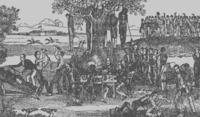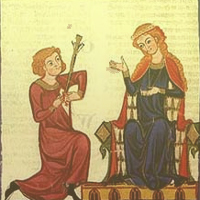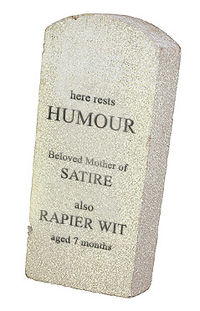Gallows Humour
“Tonight, a comedian died in New York...”
– Walter Kovacs
A historical tradition found from ancient times in England, Gallows Humour refers to the practice of allowing condemned individuals to perform on a stage prior to their execution and subsequent death. Crowds would show their appreciation through shouting disparaging comments during the performance or in some cases providing the entertainer with items of sustenance. In exceptional cases the audience would meet the performance with a stony silence as a mark of respect.
Historical references

Roman Period and Dark Ages
As on the Ides of March in 44 BC, Julius Caesar realized he was about to be murdered, the Dictator brought the house down with one of the briefest quips in history. As the conspirators closed around him, Caesar spotted a friend and smarty said “You too, Brutus?!” The target of his comment, not originally a part of the group of assassins, played the straight man perfectly, jerking upright with a look of shock on his face. “BWAAAHAHAHAH” roared the entire senate. Brutus was so angry about this comment that he went over and joined in the wholesale stabbing.
Middle Ages
| “ | Once a King, always a King, but thrice a Knight is enough... | ” |
Early primary sources citing Gallows Humour are the works of Geoffrey Chaucer, Chrétien de Troyes, as well as much of early Anglo-Norman literature. Many jokes during this period focused on the feudal relationship between a knight and a lady of the house, "Courtly Love", which represented perfect love in Medieval times, leeching techniques and occasionally gags about ethnic minorities.
Famously "The Hangman's Tale" within Chaucer's Canterbury Tales contains numerous references to Gallows Humour, and is one of the first major works within the English Language to detail some of the jokes used at that time. Examples cited include:
The Black Plague was received throughout Europe with a calamity of rats, outbreak of bodily boils, spontaneous brain-hemorrhaged fatal dancing, and waves of bad humour. The likes of which, stemming from the earlier misfortunes of mankind, are exemplified here:
- Doctor: I have some bad news and some very bad news.
- Plague Victim: Well, give me the bad news first.
- Doctor: I have, from contemplating the ancient ways and means of considering your case, arrived at a determination. You have until Vespers today to live.
- Plague Victim: UNTIL VESPERS! That’s terrible!! WHAT could be WORSE? What's the very bad news?
- Doctor: I've been trying to reach you since yesterday.
Early Modern Period
From the end of the Elizabethan Period through to the early part of the 19th Century was the time of the Highwayman, the chief penalty for which was hanging with most of the infamous and notorious highwaymen ending their lives on the gallows. John "Sixteen String Jack" Rann and Dick "Dick" Turpin met their end laughing and joking with audience members in what would become known as "Stand Up and Deliver". This time saw the beginnings of observational as well as alternative humour, in addition to the first outings for such classics as "Is that a flintlock in your pocket or are you just pleased to see me?".
Many of these individuals became very popular amongst the lower classes who took the lovable rogue's punchlines to their heart, causing many social commentators of the day to claim that "Gallows Humour is the new Classical Music". This period also the beginnings of a trend called "rapier wit", which involved saying something biting and funny before stabbing somebody in the stomach or face.
Modern Era
| “ | I left in love, in laughter, and in truth and wherever truth, love and laughter abide, I am there in spirit. | ” |
By the 20th Century dying on stage as a public spectacle had falling back to featuring in rough northern drinking establishments, and occasional late night cable shows on obscure channels. The slow lingering execution of American "Freedom Fighter" Bill Hicks, which was sponsored by Camel Cigarettes, was broadcast over a prolonged period during the 1990s, and, although currently no others have followed his lead a number of tribute artists must surely meet a similar end paying for their crimes. Soon. We hope.
Commercial applications
The long and varied history along with the oral traditions of Gallows Humour has meant that it is one of the prison communities only art forms. These can vary from the Borstal kids who've been locked up and about to pass away due to a "Kronos Death" sentence as it is known to the humane brutal cooking of the electric chair. These unique and exciting cultures have been put forward as a new way for prisons to make money, be they from collected poetry or memorabilia with some of the best lines added on T-shirts for instance.
The ethical ramifications have been toned down by prison authorities who see this lucrative arm as a way for prisoners to repay their debt to society and also to raise revenue for prisons. Allegedly conditions can also be improved for prisoners with the revenue generated, however such clams have been proved erroneous due to the fact that usually when prisoners contribute to the culture of "Gallows Humour" their executions are imminent.


